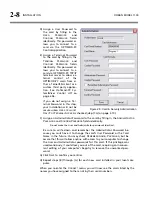
OPTIMOD-PC INTRODUCTION
1-31
When driven by the multiband compressor alone, the input/output delay is ap-
proximately 3-4ms (depending on whether the analog or digital input is used and
whether sample rate conversion is used). This delay can still be uncomfortable to
some, but many DJ/presenters find it acceptable and almost anyone can get used to
it.
Such problems can be avoided completely if the DJ/presenter’s headphones are
driven directly from the program line or, better, by an inexpensive compressor con-
nected to the program line. If the DJ/presenter relies principally on headphones to
determine whether a digital radio station is on the air, simple loss-of-data and loss-
of-audio alarms should be added to the system. Such alarms could be configured to
cut off audio to the DJ/presenter’s phones when an audio or carrier failure occurs.
Streaming and Netcasting Applications
This section was written in early 2006. As the state of the art in netcasting is chang-
ing with ferocious rapidity, we expect it to become outdated quickly. Please check
Orban’s web site, www.orban.com, for newer information.
Using OPTIMOD-PC in Streaming Applications
You need an audio source connection (either analog, AES3 digital, or SPDIF digital).
The digital input can accept any sample rate from 20 to 96 kHz. You can also use any
stream available within the computer’s internal WAVE audio system, such as a digi-
tal playout system.
One of the outputs of OPTIMOD-PC’s routing switcher sends audio back into the
computer’s internal WAVE audio system. You will ordinarily connect this stream to
the input of an encoder application, like Orban OPTICODEC-PC, RealNetworks
Real/Helix Producer, or Microsoft Windows Media Encoder running on the same host
as OPTIMOD-PC. You then apply the encoded output of the encoder to a netcast
server application, which may operate on the same machine as the encoder, or on a
different machine on your network. In the latter case, you will route the encoded
audio to the netcast server application through your network. (See
Processing for
Low Bitrate Codecs
on page 3-5.)
Using OPTIMOD-PC to Prepare Audio Files for Download
Functionally, OPTIMOD-PC is a full-duplex sound card and is seen as such by the
computer’s operating system. This means that it can support record and playback
functions simultaneously. You can use any application that allows simultaneous
playback and recording of audio files to process the raw files before they are en-
coded with an application like Orban’s OPTICODEC-PC FE. With OPTICODEC-PC FE,
this is a one-step process: Send the unprocessed file through Optimod-PC and apply
OPTIMOD-PC’s WAVE output to the input of OPTICODEC-PC FE, which will write an
encoded file suitable for serving to player clients on demand or for download. With
other encoders, you may have to first write a file containing the OPTIMOD-PC-
processed audio and then apply that file to the input of the encoding application.
















































